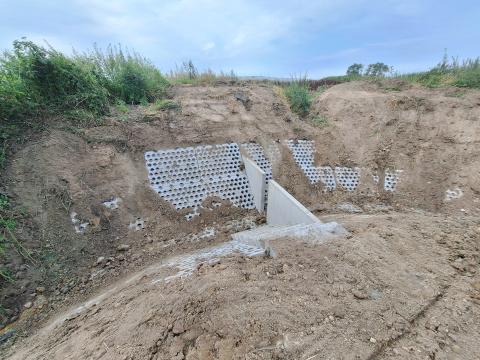
Public - private collaboration to buffer water against flooding and drought.

About this good practice
The Province of West Flanders manages 3650 km of waterways. These watercourses are rain fed. Consequently, their flowrates can rise rapidly (flooding). On the other hand, watercourses can run dry after a short dry period (water shortage). To tackle these issues, the province creates ‘controlled flooding areas’ in strategic places. These buffer water during flooding and preserve the water to be used during drought.
However, the realisation of such large-scale projects come up against many practical problems. The necessary land needs to be acquired and when digging out the buffer, large quantities of soil must be removed... This soil has to be reprocessed on the fields of farmers. These processes are very costly, but it also takes a lot of time to convince landowners who not always need water themselves.
To deal with this, the Province developed a cooperation project in which a small-scale buffer and storage volume is realised on the farmers' property. In order to efficiently feed the buffer, a restriction is placed in the watercourse raising the water level locally. An inflow pipe is placed towards the buffer. As soon as there is enough water in the watercourse, the supply can thus be replenished.
The province will bear the costs for design, permit application, digging costs and work on the watercourse. The farmer will provide a suitable location and process the removed soil. He becomes the owner of the buffer and is responsible to maintain it for a period of 20 years.
Expert opinion
Resources needed
To execute the projects, a budget of €60.000 per project was foreseen. In addition to the financial resources, there is a staff consisting of a designer and an intermediary who will make the necessary arrangements with the farmers concerned.
Evidence of success
When all projects will be executed, an additional volume of 19.000 m³ against flooding and an additional water supply of 24.000 m³ will have been realized, without the province having to acquire any land. Moreover, it is demand-driven as the farmers concerned wish to realise a water reserve. In addition, less pumping is needed to get the water on the crops as the water buffer is located on the farmers own land.
Potential for learning or transfer
Climate change will make periods of heavy precipitation and periods of water shortages more frequent and intense. Controlled flooding areas can be part of the solution to both problems. The choice to go for large-scale projects or for many small ones depends on the possibilities of the geography, the seize of the waterway and the water demand of the farmers located next to these waterways. Another key factor is the capacity of the designer and the intermediary to optimise the benefits for both the farmer (water supply) and the public authority (defense against flooding). The appropriate way to measure the success of this practice are the cubic meter of water buffered.
A strength of the practice is its demand-driven character as the farmers concerned wish to realise a water reserve. In addition, less pumping is needed to get the water on the crops as the water buffer is located on the farmer’s own land.
Further information
Images








